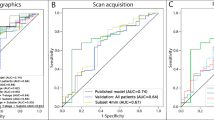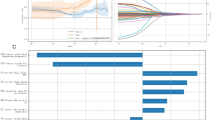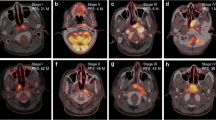Abstract
Purpose/objective
The purpose of the study is to externally validate published 18F-FDG-PET radiomic models for outcome prediction in patients with oropharyngeal cancer treated with chemoradiotherapy.
Material/methods
Outcome data and pre-radiotherapy PET images of 100 oropharyngeal cancer patients (stage IV:78) treated with concomitant chemotherapy to 66–69 Gy/30 fr were available. Tumors were segmented using a previously validated semi-automatic method; 450 radiomic features (RF) were extracted according to IBSI (Image Biomarker Standardization Initiative) guidelines. Only one model for cancer-specific survival (CSS) prediction was suitable to be independently tested, according to our criteria. This model, in addition to HPV status, SUVmean and SUVmax, included two independent meta-factors (Fi), resulting from combining selected RF clusters. In a subgroup of 66 patients with complete HPV information, the global risk score R was computed considering the original coefficients and was tested by Cox regression as predictive of CSS. Independently, only the radiomic risk score RF derived from Fi was tested on the same subgroup to learn about the radiomics contribution to the model. The metabolic tumor volume (MTV) was also tested as a single predictor and its prediction performances were compared to the global and radiomic models. Finally, the validation of MTV and the radiomic score RF were also tested on the entire dataset.
Results
Regarding the analysis of the subgroup with HPV information, with a median follow-up of 41.6 months, seven patients died due to cancer. R was confirmed to be associated to CSS (p value = 0.05) with a C-index equal 0.75 (95% CI=0.62–0.85). The best cut-off value (equal to 0.15) showed high ability in patient stratification (p=0.01, HR=7.4, 95% CI=1.6–11.4). The 5-year CSS for R were 97% (95% CI: 93–100%) vs 74% (56–92%) for low- and high-risk groups, respectively. RF and MTV alone were also significantly associated to CSS for the subgroup with an almost identical C-index. According to best cut-off value (RF>0.12 and MTV>15.5cc), the 5-year CSS were 96% (95% CI: 89–100%) vs 65% (36–94%) and 97% (95% CI: 88–100%) vs 77% (58–93%) for RF and MTV, respectively. Results regarding RF and MTV were confirmed in the overall group.
Conclusion
A previously published PET radiomic model for CSS prediction was independently validated. Performances of the model were similar to the ones of using only the MTV, without improvement of prediction accuracy.




Similar content being viewed by others
Data availability
The datasets generated during and/or analyzed during the current study are available from the corresponding author on reasonable request.
References
Sung H, Ferlay J, Siegel RL, Laversanne M, Soerjoemataram I, Jemal A, Bray F. Global Cancer Statistics 2020: GLOBOCAN estimates of incidence and mortality worldwide for 36 cancers in 185 countries. CA Cancer J Clin. 2021;71:209–49.
Siegel RL, Miller KD, Jemal A. Cancer statistics, 2017. CA Cancer J Clin. 2017;67:7–30.
Marcu LG, Boyd C, Bezak E. Feeding the data monster: data science in head and neck cancer for personalized therapy. J Am Coll Radiol. 2019;16:12.
El Naqa I. Biomedical informatics and panomics for evidence-based radiation therapy. WIREs Data Mining Knowl Discov. 2014;4:327–40.
Ebrahim A, Brunk E, Tan J, et al. Multi-omic data integration enables discovery of hidden biological regularities. Nat Commun. 2016;7:13091.
Vallières M, Zwanenburg A, Badic B, et al. Responsible radiomics research for faster clinical translation. Nucl Med. 2018;59(2):189–93. https://doi.org/10.2967/jnumed.117.200501.
Vallières M, Kay-Rivest E, Perrin LJ, et al. Radiomics strategies for risk assessment of tumour failure in head-and-neck cancer. Sci Rep. 2017;7:10117. https://doi.org/10.1038/s41598-017-10371-5.
Aerts HJWL, et al. Decoding tumour phenotype by noninvasive imaging using a quantitative radiomics approach. Nat Commun. 2014;5:4006.
Ger R, Zhou S, Elgohari B, et al. Radiomics features of the primary tumor fail to improve prediction of overall survival in large cohorts of CT- And PET-imaged head and neck cancer patients. PLoS ONE. 2019;14(9):e0222509.
Keek S, Sanduleanu S, Wesseling F, et al. Computed tomography-derived radiomic signature of head and neck squamous cell carcinoma (peri)tumoral tissue for the prediction of locoregional recurrence and distant metastasis after concurrent chemoradiotherapy. PLoS ONE. 2020;15(5):e0232639.
Welch ML, McIntosh C, Haibe-Kains B, et al. Vulnerabilities of radiomic signature development: the need for safeguards. Radiother Oncol. 2019;130:2–9.
Cozzi L, Franzese C, Fogliata A, et al. Predicting survival and local control after radiochemotherapy in locally advanced head and neck cancer by means of computed tomography based radiomics. Strahlenther Onkol. 2019;195(9):805–18.
Meneghetti AR, Zwanenburg A, Leger A, et al. Definition and validation of a radiomics signature for loco-regional tumour control in patients with locally advanced head and neck squamous cell carcinoma. Clin Transl Radiat Oncol. 2021;26:62–70.
Zhai TT, Langendijk JA, van Dijk LV, et al. Pre-treatment radiomic features predict individual lymph node failure for head and neck cancer patients. Radiother Oncol. 2020;146:58–65.
Volpe S, Pepa M, Zaffaroni M, et al. Machine learning for head and neck cancer: a safe bet? A clinically oriented systematic review for the radiation oncologist. Front Oncol. 2021;11:772663.
Le WT, Vorontsov E, Romero FP, et al. Cross-institutional outcome prediction for head and neck cancer patients using self-attention neural networks. Sci Rep. 2022;12(1):3183.
Giraud P, Giraud P, Gasnier A, et al. Radiomics and machine learning for radiotherapy in head and neck cancers. Front Oncol. 2019;9:174.
Martens RM, Koopman T, Noij DP, et al. Predictive value of quantitative 18F-FDG-PET radiomics analysis in patients with head and neck squamous cell carcinoma. EJNMMI Res. 2020;10:102.
Feliciani G, Fioroni F, Grassi E et al. Radiomic profiling of head and neck cancer: 18F-FDG PET texture analysis as predictor of patient survival. Contrast Media Mol. Imaging, 2018 3574310
Zwanenburg A, Vallières M, Abdalah MA, et al. The Image Biomarker Standardization Initiative: standardized quantitative radiomics for high-throughput image-based Phenotyping. Radiology. 2020;295(2):328–38. https://doi.org/10.1148/radiol.2020191145.
Kundu S. AI in medicine must be explainable. Nat Med. 2021;27:1328.
Fiorino C, Rancati T. Artificial intelligence applied to medicine: there is an “elephant in the room.” Phys Med. 2022;98:8–10.
Fiorino C, Dell’Oca I, Pierelli A, et al. Simultaneous integrated boost (SIB) for nasopharynx cancer with helical tomotherapy: a planning study. Strahlenther Onkol. 2007;39:497–505.
Widesott L, Pierelli A, Fiorino C, et al. Intensity-modulated proton therapy versus helical tomotherapy in nasopharynx cancer: planning comparison and NTCP evaluation. Int J Radiat Oncol Biol Phys. 2008;72:589–96.
Mori M, Passoni P, Incerti E, et al. Training and validation of a robust PET radiomic-based index to predict distant-relapse-free-survival after radio-chemotherapy for locally advanced pancreatic cancer. Radiother Oncol. 2020;153:258–64.
Collins GS, Reitsma JB, Altman DG, et al. Transparent reporting of a multivariable prediction model for individual Prognosis or diagnosis (TriPod): the TriPod statement. Ann intern Med. 2015;162:55–63.
Belli ML, Mori M, Broggi S, Cattaneo GM, Bettinardi V, Dell’Oca I, Fallanca F, Passoni P, Vanoli EM, Calandrino R, Di Muzio N, Picchio M, Fiorino C. Quantifying the robustness of [18F]FDG-PET/CT radiomic features with respect to tumor delineation in head and neck and pancreatic cancer patients. Phys Med. 2018;49:105–11.
Tixier F, Hatt M, Le Rest CC, et al. Reproducibility of tumor uptake heterogeneity characterization through textural feature analysis in 18F-FDG PET. J Nucl Med. 2012;53(5):693–700.
Presotto L, Bettinardi V, De Bernardi E, et al. PET textural features stability and pattern discrimination power for radiomics analysis: an “ad-hoc” phantoms study. Phys Med. 2018;50:66–74.
Whybra P, Parkinson C, Foley K, et al. Assessing radiomic feature robustness to interpolation in 18 F-FDG PET imaging. Scientific Reports. 2019;9(1):9649.
Piazzese C, Foley K, Whybra P, et al. Discovery of stable and prognostic CT-based radiomic features independent of contrast administration and dimensionality in oesophageal cancer. PLOS ONE. 2019;14(11):e0225550. https://doi.org/10.1371/journal.pone.0225550.
Elhalawani H, Kanwar A, Mohamed ASR, et al. Investigation of radiomic signatures for local recurrence using primary tumor texture analysis in oropharyngeal head and neck cancer patients. Scientific Reports. 2018;8(1):1524.
Ou D, Blanchard P, Rosellini S, et al. Predictive and prognostic value of CT based radiomics signature in locally advanced head and neck cancers patients treated with concurrent chemoradiotherapy or bioradiotherapy and its added value to Human Papillomavirus status. Oral Oncology. 2017;71:150–5.
Sun R, Limkin EJ, Vakalopoulou M, et al. A radiomics approach to assess tumour-infiltrating CD8 cells and response to anti-PD-1 or anti-PD-L1 immunotherapy: an imaging biomarker, retrospective multicohort study. The Lancet Oncology. 2018;19(9):1180–91.
Masson I, Da-ano R, Lucia F, et al. Statistical harmonization can improve the development of a multicenter CT-based radiomic model predictive of nonresponse to induction chemotherapy in laryngeal cancers. Med Phys. 2021;48(7):4099–109.
Lv Wenbing, Hui Xu, Han Xu, et al. Context-aware saliency guided radiomics: application to prediction of outcome and HPV-status from multi-center PET/CT images of head and neck cancer. Cancers. 2022;14:1674.
Picchio M, Kirienko M, Mapelli L, et al. Predictive value of F18-FDGPET/CT for the outcome of F18-FDG PET-guided radiotherapy in patients with head-neck cancer. Eur J Nucl Med Mol Imaging. 2014;41:21–31.
Schwartz DL, Harris J, Yao M, et al. Metabolic tumor volume as a prognostic imaging-based biomarker for head-and-neck cancer: pilot results from Radiation Therapy Oncology Group protocol 0522. Int J Radiat Oncol Biol Phys. 2015;91:721–9.
Rijo-Cedeño J, Mucientes J, Álvarez O, et al. Metabolic tumor volume and total lesion glycolysis as prognostic factors in head and neck cancer: systematic review and meta-analysis. Head and Neck. 2020;42:3744–54.
Won Kim J, Oh JS, Roh JL, Kim JS, Choi SH, Nam SY, Sang Kim SY. Prognostic significance of standardized uptake value and metabolic tumour volume on 18F-FDG PET/CT in oropharyngeal squamous cell carcinoma. European J Nuclear Medicine and Molecular Imaging. 2015;42:1353–61.
Funding
The project was supported by an AIRC (Associazione Italiana per la Ricerca sul Cancro) grant (IG23150).
Author information
Authors and Affiliations
Contributions
All authors contributed to the study conception and design. Material preparation, data collection, and analysis were performed by M Mori, C Deantoni, M Olivieri, A Chiara, S Baroni, C Fiorino, and I Dell’Oca. The first draft of the manuscript was written by M Mori and C Fiorino, and all authors commented on previous versions of the manuscript. All authors read and approved the final manuscript.
Corresponding author
Ethics declarations
Ethics approval
This study was performed in line with the principles of the Declaration of Helsinki. Approval was granted by the Ethics Committee of San Raffaele Scientific Institute (March 10th, 2022/N° 12/INT/2022).
Consent to participate/to publish
Written informed consent for the execution of PET/CT and anonymous publication of disease-related information was signed by each patient.
Competing interests
The authors declare no competing interests.
Additional information
Publisher's note
Springer Nature remains neutral with regard to jurisdictional claims in published maps and institutional affiliations.
This article is part of the Topical Collection on Advanced Image Analyses (Radiomics and Artificial Intelligence)
Supplementary Information
Below is the link to the electronic supplementary material.
Rights and permissions
Springer Nature or its licensor (e.g. a society or other partner) holds exclusive rights to this article under a publishing agreement with the author(s) or other rightsholder(s); author self-archiving of the accepted manuscript version of this article is solely governed by the terms of such publishing agreement and applicable law.
About this article
Cite this article
Mori, M., Deantoni, C., Olivieri, M. et al. External validation of an 18F-FDG-PET radiomic model predicting survival after radiotherapy for oropharyngeal cancer. Eur J Nucl Med Mol Imaging 50, 1329–1336 (2023). https://doi.org/10.1007/s00259-022-06098-9
Received:
Accepted:
Published:
Issue Date:
DOI: https://doi.org/10.1007/s00259-022-06098-9




